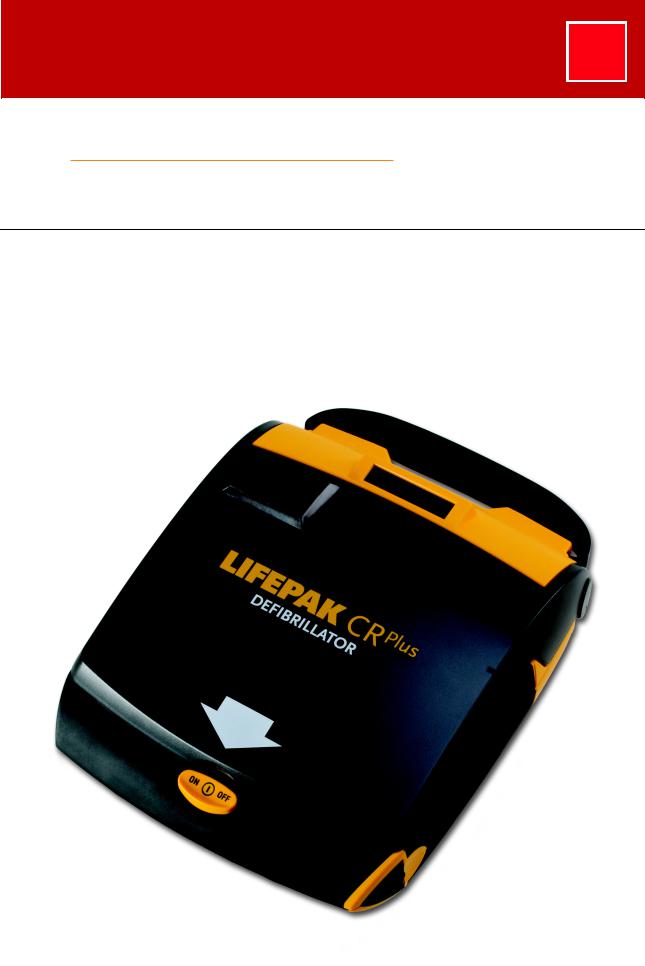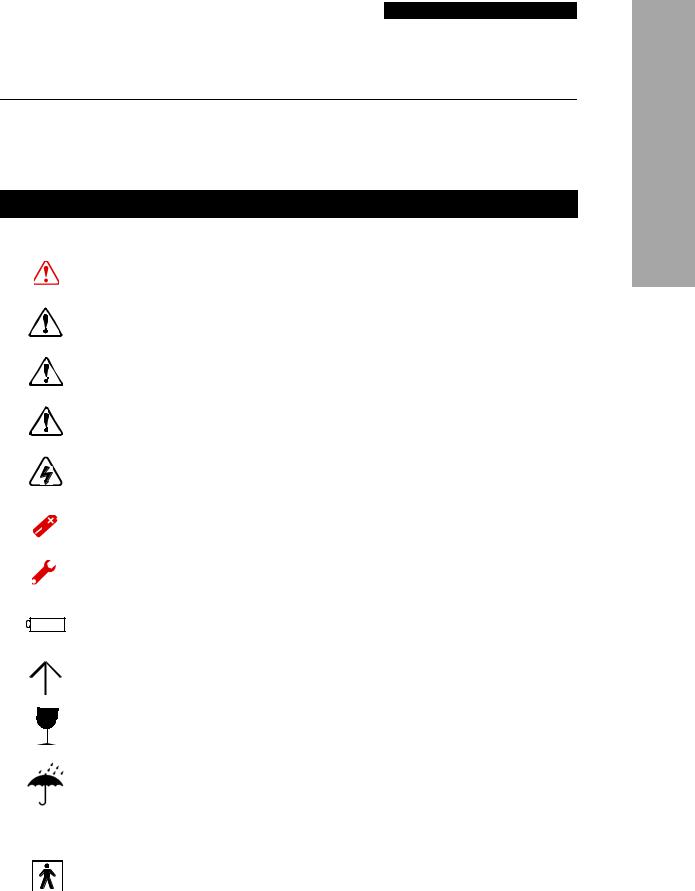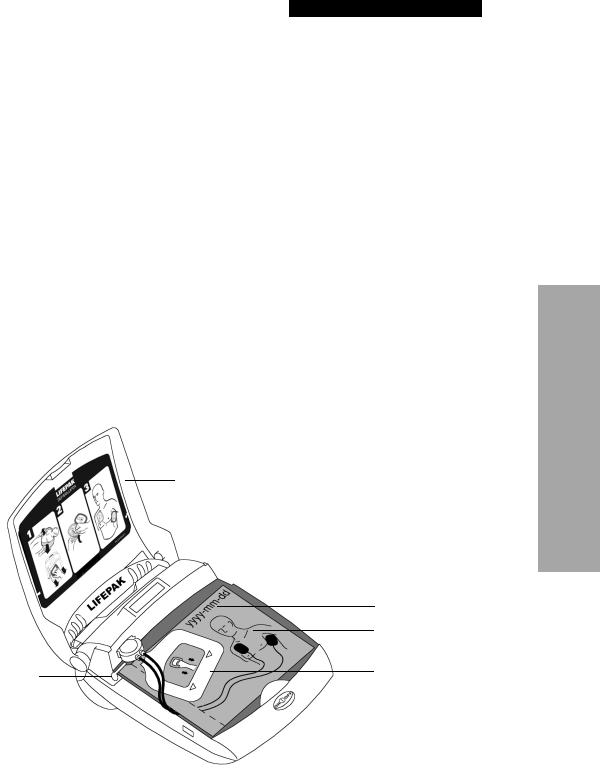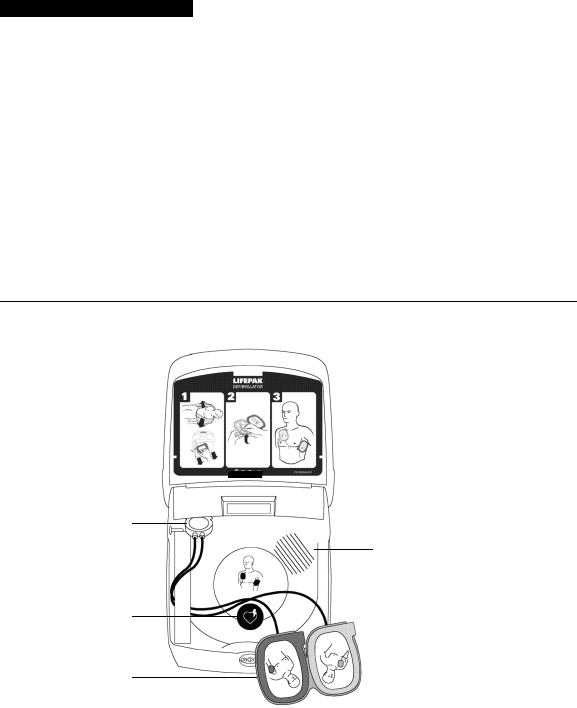Physio-Control LIFEPAK CR Plus User Manual

+
LIFEPAK CR® Plus DEFIBRILLATOR
LIFEPAK EXPRESS® DEFIBRILLATOR
OPERATING INSTRUCTIONS

LIFEPAK CR®Plus DEFIBRILLATOR
LIFEPAK EXPRESS® DEFIBRILLATOR
OPERATING INSTRUCTIONS

Responsibility for Information
It is the responsibility of our customers to ensure that the appropriate person(s) who may use this defibrillator have access to the information in this manual, including general safety information provided in Section 1.
!USA Rx Only
Device Tracking
!USA The U.S. Food and Drug Administration requires defibrillator manufacturers and distributors to track the location of their defibrillators. If the device is located somewhere other than the shipping address or the device has been sold, donated, lost, stolen, exported, destroyed, permanently retired from use, or if the device was not obtained directly from Physio-Control, please do one of the following: register the device at http://www.physio-control.com, call the device tracking coordinator at 1.800.426.4448, or use one of the postage-paid address change cards located in the back of this manual to update this vital tracking information.
Revision History
These operating instructions describe the LIFEPAK CR Plus and LIFEPAK EXPRESS defibrillators with software Version 3.0 or later.
LIFEPAK, LIFEPAK CR, LIFEPAK EXPRESS, and QUIK-COMBO are registered trademarks of Physio-Control, Inc. ADAPTIV, CODE-STAT,
CHARGE-PAK, QUIK-PAK, and Shock Advisory System are trademarks of Physio-Control, Inc. IrDA is a registered trademark of Infrared Data
Association. Specifications are subject to change without notice.
©2009-2010 Physio-Control, Inc. All rights reserved.
Publication Date: 05/2010 |
MIN |
3201686-012 |

TABLE OF CONTENTS
1 Introduction
About Automatic External Defibrillators ............................................................................................... |
1-2 |
Indications for Use........................................................................................................................ |
1-2 |
Contraindications ......................................................................................................................... |
1-2 |
Why the Need for Defibrillators .................................................................................................... |
1-2 |
Terminology.................................................................................................................................. |
1-3 |
Text Conventions.......................................................................................................................... |
1-4 |
Safety Information ................................................................................................................................ |
1-4 |
Safety Terms ................................................................................................................................ |
1-4 |
General Warnings and Cautions .................................................................................................. |
1-5 |
Symbols ............................................................................................................................................... |
1-7 |
About the LIFEPAK CR Plus and LIFEPAK EXPRESS Defibrillators ................................................ |
1-10 |
Capabilities and Features........................................................................................................... |
1-10 |
2 Getting Started
Unpacking and Inspecting Your LIFEPAK CR Plus or LIFEPAK EXPRESS Defibrillator ..................... |
2-2 |
Where to Locate Your LIFEPAK CR Plus or LIFEPAK EXPRESS Defibrillator .................................... |
2-3 |
Controls, Indicators, and Labels .......................................................................................................... |
2-4 |
Outside Controls, Indicators, and Labels ..................................................................................... |
2-4 |
Inside Features............................................................................................................................. |
2-5 |
3 Using the Defibrillator
Warnings and Cautions ........................................................................................................................ |
3-2 |
Responding to a Sudden Cardiac Arrest Emergency .......................................................................... |
3-2 |
Basic Steps for Using the LIFEPAK CR Plus or LIFEPAK EXPRESS Defibrillator....................... |
3-3 |
What to Do After Emergency Medical Personnel Arrive............................................................... |
3-5 |
What to Do After Using Your Defibrillator ..................................................................................... |
3-5 |
Voice Instructions and Tones ............................................................................................................... |
3-5 |
Troubleshooting .................................................................................................................................... |
3-6 |
LIFEPAK CR Plus and LIFEPAK EXPRESS Defibrillator Operating Instructions |
iii |
©2009-2010 Physio-Control, Inc.

4 Data Storage
Overview of Data Storage .................................................................................................................... |
4-2 |
Data Stored by Your Defibrillator .................................................................................................. |
4-2 |
Test and Service Data .................................................................................................................. |
4-2 |
Event and Test Log....................................................................................................................... |
4-3 |
5 Caring for Your Defibrillator
Maintaining a State of Readiness ........................................................................................................ |
5-2 |
Replacing the CHARGE-PAK Battery Charger and the QUIK-PAK Electrode Packet ......................... |
5-2 |
Replacing the CHARGE-PAK Battery Charger ............................................................................ |
5-4 |
Replacing the QUIK-PAK Electrode Packet.................................................................................. |
5-6 |
Storing Your Defibrillator ...................................................................................................................... |
5-7 |
Cleaning Your Defibrillator ................................................................................................................... |
5-7 |
Obtaining Authorized Service .............................................................................................................. |
5-8 |
Recycling Information .......................................................................................................................... |
5-8 |
Recycling Assistance ................................................................................................................... |
5-8 |
Preparation................................................................................................................................... |
5-8 |
Recycling of Disposable Electrodes............................................................................................. |
5-8 |
Packaging..................................................................................................................................... |
5-8 |
Supplies, Accessories, and Training Tools ........................................................................................... |
5-8 |
Warranty Information ........................................................................................................................... |
5-8 |
6 Defibrillator Operating Settings
Operating Settings and Setup Configuration ....................................................................................... |
6-2 |
A Specifications
B Shock Advisory System
C User’s Checklist
D Electromagnetic Compatibility Guidance
Index
iv |
LIFEPAK CR Plus and LIFEPAK EXPRESS Defibrillator Operating Instructions |

Introduction 1
INTRODUCTION
This section provides background information about defibrillation and includes an overview of LIFEPAK CR Plus and LIFEPAK EXPRESS defibrillator features.
About Automatic External Defibrillators |
page 1-2 |
Safety Information |
1-4 |
Symbols |
1-6 |
About the LIFEPAK CR Plus and |
1-10 |
LIFEPAK EXPRESS Defibrillators |
|
|
|
LIFEPAK CR Plus and LIFEPAK EXPRESS Defibrillator Operating Instructions |
1-1 |
©2009-2010 Physio-Control, Inc.

Introduction
ABOUT AUTOMATIC EXTERNAL DEFIBRILLATORS
The LIFEPAK CR Plus and LIFEPAK EXPRESS defibrillators are automated external defibrillators (AEDs). For many years, defibrillators have been used only by medical professionals to treat victims in sudden cardiac arrest (SCA). Today, the ability of defibrillators to save lives is so widely recognized that people once trained to do only cardiopulmonary resuscitation (CPR) can now use defibrillators.
After electrode pads are applied to the victim’s chest, the defibrillator analyzes the victim’s heart rhythm. If a shockable rhythm is detected, the defibrillator will either deliver an intense pulse of electricity (shock) to the heart muscle (fully automatic model) or direct the responder to deliver the shock (semiautomatic model). The defibrillator delivers shocks through the electrode pads on the victim’s chest.
When this pulse of electricity is delivered, it is called defibrillation. Defibrillation is recognized for treating life-threatening heart beat irregularities, such as ventricular fibrillation, that cause SCA.
The LIFEPAK CR Plus and LIFEPAK EXPRESS defibrillators are designed specifically for infrequent use and for use by people whose only training is in CPR and in using AEDs.
Indications for Use
The LIFEPAK CR Plus and LIFEPAK EXPRESS defibrillators are indicated for use on patients in cardiac arrest. The patient must be unresponsive (unconscious), not breathing normally, and showing no signs of circulation (for example, no pulse, no coughing, or no movement). With Infant/Child Reduced Energy Defibrillation Electrodes, the LIFEPAK CR Plus and LIFEPAK EXPRESS defibrillators may be used on children who are up to 8 years old or who weigh up to 25 kg (55 lb).
Contraindications
None known.
Why the Need for Defibrillators
The American Heart Association estimates that, in the USA alone, at least 250,000 people die each year of cardiac arrest. Of these, about 10,000 people might have been saved had they received immediate treatment from a defibrillator.
Sudden cardiac arrest is usually caused by a malfunction in the heart’s electrical system. Called ventricular fibrillation, this critical condition prevents the heart from pumping blood throughout the body. Ventricular fibrillation can cause death within seconds.
Defibrillation is a relatively simple procedure that involves placing electrode pads on a victim’s exposed chest and delivering an electrical shock to the heart. The externally-delivered shock often restores the heart’s electrical system to normal rhythm. Combined with CPR, defibrillation provides the most effective care for victims in cardiac arrest.
1-2 |
LIFEPAK CR Plus and LIFEPAK EXPRESS Defibrillator Operating Instructions |

Introduction
Terminology
The following terms appear in this manual.
AED |
Automated External Defibrillator. A device that evaluates the victim’s heart |
|
rhythm and delivers an electrical shock to the heart if a shockable rhythm is |
|
detected. |
Cardiac arrest |
The termination of the heart’s pumping action resulting in the lack of a |
|
heartbeat or pulse and breathing. |
CPR |
Cardiopulmonary resuscitation. This involves delivering rescue breathing and |
|
chest compressions to a victim in cardiac arrest. |
Defibrillation |
Delivery of an electrical shock to the heart for the purpose of reversing |
|
ventricular fibrillation. |
ECG |
Electrocardiogram. A composite picture of what is occurring electrically in the |
|
heart. |
Fibrillation |
Chaotic activity of the heart’s electrical system. This condition can occur in |
|
the atria or the ventricles. When it occurs in the ventricles, they quiver in a |
|
rapid, chaotic manner, preventing them from pumping blood to the body. |
Heart attack |
A nonspecific term referring to the death of heart muscle resulting from |
|
interruption of blood supply, often confused with cardiac arrest. |
Impedance |
Resistance to the flow of electrical current through the body. |
Joule |
The basic unit of energy delivered by a defibrillator. |
LED |
Light emitting diodes. |
Myocardial infarction |
The specific term for what is usually meant by heart attack; death of heart |
|
muscle resulting from an interruption of the blood supply to that area of |
|
myocardium. |
Nonshockable rhythm |
A heart rhythm that is detected by the defibrillator that does not need a |
|
shock, but may need CPR. |
Victim |
In this manual, the person suffering from cardiac arrest. |
Responder |
In this manual, the person giving aid to a victim in cardiac arrest. Used |
|
interchangeably with user. |
SAS |
Physio-Control patented Shock Advisory System™. |
Shockable rhythm |
A heart rhythm that is detected by the defibrillator as requiring a shock, for |
|
example, ventricular fibrillation. |
User |
In this manual, the person giving aid to a victim in cardiac arrest. Used |
|
interchangeably with responder. |
Ventricular fibrillation |
A life-threatening chaotic heart rhythm. |
Ventricular tachycardia |
Rapid heart rhythm originating in the ventricle. |
LIFEPAK CR Plus and LIFEPAK EXPRESS Defibrillator Operating Instructions |
1-3 |
©2009-2010 Physio-Control, Inc.
Introduction 1

Introduction
Text Conventions
Throughout this manual, special text characters are used to indicate labels and voice instructions:
Operating control labels: CAPITAL LETTERS such as ON/OFF and SHOCK.
Voice instructions: ITALICIZED CAPITAL LETTERS such as STAND CLEAR.
SAFETY INFORMATION
This section provides important information to help you safely operate your defibrillator. Familiarize yourself with all of the terms, warnings, and symbols presented in this section.
Safety Terms
You may encounter the following terms in this manual and while using your defibrillator:
Danger Immediate hazards that will result in serious personal injury or death to the user and/or the victim.
Warning Hazards or unsafe practices that could result in serious personal injury or death to the user and/or the victim.
Caution Hazards or unsafe practices that could result in minor personal injury to the user and/or the victim, product damage, or property damage.
1-4 |
LIFEPAK CR Plus and LIFEPAK EXPRESS Defibrillator Operating Instructions |

Introduction
General Warnings and Cautions
WARNINGS!
Shock hazard.
The defibrillator delivers up to 360 joules of electrical energy. Unless properly used as described in this manual, this electrical energy may cause serious injury or death. Do not attempt to operate this defibrillator unless thoroughly familiar with this manual and the function of all controls, indicators, connectors, and accessories.
Do not insert a finger or any object other than the CHARGE-PAK battery charger into the well of the defibrillator.
Shock or fire hazard.
Do not immerse any portion of this defibrillator in water or other fluids. Avoid spilling any fluids on the defibrillator or its accessories. Do not clean with ketones or other flammable agents. Do not autoclave or sterilize this defibrillator or the accessories unless otherwise specified.
Possible fire or explosion.
Do not store this defibrillator in the presence of flammable gases or in direct contact with flammable material.
Do not use this defibrillator in the presence of flammable gases or anesthetics. Use care when operating this defibrillator close to oxygen sources (such as bag-valve-mask device or ventilator tubing). Turn off gas source or move source away from patient during defibrillation.
Possible device shutdown.
When the attention symbol  first appears on the readiness display, only a small number of shocks and monitoring time are available. Always keep a CHARGE-PAK™ battery charger in the defibrillator. Routinely check that the defibrillator is ready for use. Replace the CHARGE-PAK battery charger after each use of the defibrillator.
first appears on the readiness display, only a small number of shocks and monitoring time are available. Always keep a CHARGE-PAK™ battery charger in the defibrillator. Routinely check that the defibrillator is ready for use. Replace the CHARGE-PAK battery charger after each use of the defibrillator.
Possible electrical interference with device performance.
Equipment operating in close proximity may emit strong electromagnetic or radio frequency interference (RFI) which could affect the performance of this device. RFI may result in improper device operation, distorted ECG, failure to detect a shockable rhythm, or cessation of pacing. Avoid operating the device near cauterizers, diathermy equipment, cellular phones, or other portable and mobile RF communications equipment. Maintain equipment separation of at least 1.2 m (4 ft) and do not rapidly key EMS radios on and off. Contact a technical support representative if assistance is required.
Possible electrical interference.
Using cables, electrodes, or accessories not specified for use with this device may result in increased emissions or decreased resistance to electromagnetic interference which could affect the performance of this defibrillator or of equipment in close proximity. Use only parts and accessories specified in this manual.
Possible electrical interference.
This device may cause electromagnetic interference (EMI) especially during charge and energy transfers. EMI may affect the performance of equipment operating in close proximity. If possible, verify the effects of defibrillator discharge on other equipment prior to using the defibrillator in an emergency situation.
LIFEPAK CR Plus and LIFEPAK EXPRESS Defibrillator Operating Instructions |
1-5 |
©2009-2010 Physio-Control, Inc.
Introduction 1

Introduction
WARNINGS!
Possible improper device performance.
Using other manufacturers’ cables or electrodes may cause the defibrillator to perform improperly and invalidates the safety agency certification. Use only the parts and accessories specified in this manual.
Using damaged or expired equipment or accessories may cause the defibrillator to perform improperly and may injure the victim or the user.
Safety risk and possible equipment damage.
Monitors, defibrillators, and their accessories (including electrodes and cables) contain ferromagnetic materials. As with all ferromagnetic equipment, these products must not be used in the presence of the high magnetic field created by a Magnetic Resonance Imaging (MRI) device. The high magnetic field created by an MRI device will attract the equipment with a force sufficient to cause death or serious personal injury to persons between the equipment and the MRI device. This magnetic attraction may also damage the equipment. Skin burns will also occur due to heating of electrically conductive materials, such as patient leads and pulse oximeter sensors. Consult the MRI manufacturer for more information.
CAUTION!
Possible equipment damage.
This defibrillator may be damaged by mechanical or physical abuse, such as immersion in water or dropping the defibrillator. If the defibrillator has been abused, remove it from use and contact a qualified technician.
1-6 |
LIFEPAK CR Plus and LIFEPAK EXPRESS Defibrillator Operating Instructions |

Introduction
SYMBOLS
The following symbols may appear in this manual and on the LIFEPAK CR Plus and
LIFEPAK EXPRESS defibrillators. For more information about the readiness display symbols, refer to Section 2, "Getting Started".
Symbol Explanation
OK OK Indicator. The defibrillator is ready for use.
Attention. On the readiness display—the internal battery is low. Refer to page 2-4 for more information about the readiness display.
Attention. On the CHARGE-PAK battery charger—consult the operating instructions. Refer to page 5-4 for more information about the CHARGE-PAK battery charger.
Attention. On the safety warning—consult the operating instructions. Refer to page 1-5 for more information about the warnings and cautions.
Attention. On the electrode pads—consult the operating instructions. Refer to page 2-6 for more information about electrode pads.
Warning, high voltage.
CHARGE-PAK battery charger indicator. On the readiness display—CHARGE-PAK battery charger needs to be replaced.
Wrench indicator. There is a condition that prevents or could prevent normal defibrillator operation. Refer to page 5-7 for more information.
CHARGE-PAK battery charger.
This end up.
Fragile/breakable.
Handle with care.
Protect from water.
Power On/Off button.
Type BF patient connection.
LIFEPAK CR Plus and LIFEPAK EXPRESS Defibrillator Operating Instructions |
1-7 |
©2009-2010 Physio-Control, Inc.
Introduction 1

Introduction
Symbol Explanation
Not intended for use on children who are less than eight years of age or who weigh less than 25 kg (55 lb).
Infant/Child Reduced Energy Electrodes are not compatible with QUIK-COMBO defibrillation and therapy cables. To use Infant/Child Electrodes, connect Infant/Child Electrodes directly to the AED.
Not intended for use on adults.
Physio-Control electrodes are latex-free.
Arrow indicates ON/OFF button location.
Symbol denoting a defibrillator and identifies the shock button.
LOT YYWW Lot code.
Do not reuse—single use only.
Use By date shown: yyyy-mm-dd.
Refer to instructions for recycling procedure, page 5-8.
Refer to instructions for disposal procedure, page 5-2.
Do not dispose of this product in the unsorted municipal waste stream. Dispose of this product according to local regulations. See http://recycling.medtronic.com for instructions on the proper disposal of this product.
Mark of conformity according to the European Medical Device Directive 93/42/EEC.
Canadian Standards Association certification for Canada and the United States.
1-8 |
LIFEPAK CR Plus and LIFEPAK EXPRESS Defibrillator Operating Instructions |

Introduction
Symbol |
|
|
|
|
|
|
|
|
Explanation |
|||
|
|
|
|
|
|
|
|
|
|
|
|
|
|
|
|
|
|
|
|
|
|
|
|
|
|
|
|
!USA |
|
|
|
For USA audiences only. |
||||||
|
|
|
|
|
|
|
|
|
|
|
|
Atmospheric pressure limitation. |
|
|
|
|
|
|
|
|
|
|
|
|
Relative humidity range 5% to 95%. |
|
|
|
|
|
|
|
|
|
|
|
|
Store in a cool, dry location (0° to 50°C or 32° to 122°F). |
|
|
|
|
|
|
|
|
|
|
|
|
|
|
|
|
|
|
|
|
|
|
|
|
|
|
|
|
3550°C |
|
122°F95°F |
|
|
|
|||||
|
|
|
||||||||||
|
|
|
|
|
|
|
|
|
|
|
|
|
|
|
|
|
|
|
|
|
|
|
|
|
|
|
|
|
|
|
|
|
|
|
|
|
|
|
|
|
150°C |
|
5932°F |
Recommended storage temperature: 15° to 35°C (59° to 95°F). Storage at extreme |
|||||||
|
|
|
||||||||||
|
|
|
|
|
|
|
|
|
|
|
|
|
|
|
|
|
|
|
|
|
|
|
|
|
|
|
|
|
|
|
|
|
|
|
|
|
|
temperatures of -40° or 70°C (-40° or 158°F) is limited to seven days. If storage at |
|
|
|
|
|
|
|
|
|
|
|
|
these temperatures exceeds one week, the electrode shelf-life will be reduced. |
|
|
|
YYYY |
Date of manufacture. |
||||||||
|
|
|
|
|||||||||
|
|
|
|
|
|
|
|
|
|
|
|
CAUTION - FIRE HAZARD |
|
|
|
|
|
|
|
|
|
|
|
|
Do not disassemble, heat above 100°C (212°F), or incinerate battery |
|
|
|
|
|
|
|
|
|
|
|
|
CAUTION - FIRE HAZARD |
|
|
|
|
|
|
|
|
|
|
|
|
Do not crush, puncture, or disassemble battery |
Rx Only or |
Federal (U.S.) law restricts this device to sale by, or on the order of, a physician. |
|||||||||||
|
|
|
|
|
|
|
|
|
|
|
|
|
|
Rx Only |
|
|
|||||||||
|
|
|
|
|||||||||
|
|
|
|
|
|
|
|
|
||||
|
|
|
|
|
|
|
|
|
|
|
|
|
|
|
MIN |
|
|
|
|
Manufacturer’s Item Number. |
|||||
|
|
|
|
|
|
|
|
|
|
|||
|
|
|
|
|
|
|
||||||
CAT or |
CAT |
Catalog number used for placing orders. |
||||||||||
|
|
|
|
|
|
|||||||
REF or |
REF |
|
Reorder number. |
|||||||||
|
|
|
|
|||||||||
SN or |
SN |
|
Serial number. |
|||||||||
|
|
|
|
|
|
|
|
|
|
|
|
|
LIFEPAK CR Plus and LIFEPAK EXPRESS Defibrillator Operating Instructions |
1-9 |
©2009-2010 Physio-Control, Inc.
Introduction 1

Introduction
ABOUT THE LIFEPAK CR PLUS AND LIFEPAK EXPRESS DEFIBRILLATORS
The LIFEPAK CR Plus and LIFEPAK EXPRESS defibrillators are designed for indoor and outdoor use. Each has two models available—fully automatic and semiautomatic. After the electrode pads are applied, the fully automatic model evaluates the heart rhythm and, if a shockable rhythm is detected, delivers a shock without any responder assistance. The semiautomatic model evaluates the heart rhythm but requires the responder to press the shock button if a shockable rhythm is detected. Both models have voice instructions that guide the responder through the defibrillation process.
Capabilities and Features
The following paragraphs introduce specific features found in the defibrillators.
Accessories
The defibrillator arrives with an installed CHARGE-PAK battery charger, one preconnected QUIK-PAK™ electrode packet, and the operating instructions. Refer to Section 5 for other accessories.
Automated Operation
Voice instructions guide the responder through the defibrillation process.
The fully automatic defibrillator requires no operator interaction beyond placing the electrode pads on the victim. If the defibrillator detects a shockable rhythm, it warns the responder prior to delivering any shock, and then delivers a shock without operator interaction.
The semiautomatic defibrillator has a highly visible shock button that the responder must press when the defibrillator issues a shock voice instruction.
Automatic Self-Tests
The defibrillator tests itself each week and every time you turn it on. In addition, every month, the defibrillator performs a more extensive self-test. This self-test checks the defibrillator’s circuitry to verify that it is ready for use.
ClearVoice™ Technology
ClearVoice technology was created specifically for portable medical devices. This technology incorporates how the human ear interprets audio prompts and instructions within real world cardiac arrest response scenes such as shopping malls, on the freeway, or in an emergency room. ClearVoice technology minimizes distortion and enhances speech intelligibility so the user can clearly understand audio and instructional prompts in a chaotic and stressful environment.
Customized Setup
The defibrillator is shipped ready to use with the preprogrammed ADAPTIV™ biphasic escalating energy protocol and other operating settings. The operating settings are configured in accordance with customer order. Refer to Section 6, "Defibrillator Operating Settings".
Data Management
The defibrillator digitally stores data when it is turned on and the electrode pads are successfully applied to the victim. The stored data includes date and time, ECG data, and the number of shocks. The defibrillator also stores the results of the automatic self-tests.
Stored data can be transferred to a PC by means of a serial infrared link, the IrDA® port. A data transfer and management program running on the PC transfers event and test data from the defibrillator.
1-10 |
LIFEPAK CR Plus and LIFEPAK EXPRESS Defibrillator Operating Instructions |

Introduction
Defibrillation Electrodes (Pads)
When applied to the victim, Physio-Control QUIK-PAK defibrillation electrodes (pads) work with the defibrillator to monitor the heart rhythm and identify when a shock should be delivered. If victim care is transferred to emergency medical personnel, these electrode pads can be disconnected from the defibrillator and reconnected to other AEDs or defibrillators that are compatible with QUIK-COMBO® electrodes.
For infants or children who are less than eight years of age or weigh less than 25 kg (55 lb), use Infant/Child Reduced Energy Defibrillation Electrodes. These electrodes reduce the energy delivered by the AED to the victim by approximately 75%. Keep all electrode pads with the AED.
Defibrillation Waveform
The defibrillation shock, using ADAPTIV Biphasic technology, is delivered in the form of a biphasic truncated exponential (BTE) defibrillation waveform.
Heart Rhythm Analysis
The Physio-Control patented Shock Advisory System™ evaluates the victim’s heart rhythm. Refer to "Appendix B" for further information.
Motion Detection
This patented motion system detects victim or operator motion that could affect the heart rhythm evaluation. Heart rhythm evaluation is interrupted if the defibrillator detects motion.
Readiness Display
This easy-to-read visual display indicates if the defibrillator is ready for use or if it needs attention.
SafeGuard™ Power System
The SafeGuard power system offers a dual layer of security as the CHARGE-PAK battery charger helps keep the rechargeable internal lithium battery at its optimum level. The internal battery supplies power to operate the defibrillator. It is important to keep a CHARGE-PAK battery charger in the defibrillator, even when the defibrillator is stored. Refer to "Replacing the CHARGE-PAK Battery Charger and the QUIK-PAK Electrode Packet" on page 5-2 for more information.
Introduction 1
LIFEPAK CR Plus and LIFEPAK EXPRESS Defibrillator Operating Instructions |
1-11 |
©2009-2010 Physio-Control, Inc.

GETTING STARTED
Started Getting 2
This section provides an orientation to the LIFEPAK CR Plus and LIFEPAK EXPRESS defibrillators and describes how to prepare the defibrillator for use.
Unpacking and Inspecting Your |
page 2-2 |
LIFEPAK CR Plus or LIFEPAK EXPRESS |
|
Defibrillator |
|
Where to Locate Your LIFEPAK CR Plus or |
2-3 |
LIFEPAK EXPRESS Defibrillator |
|
Controls, Indicators, and Labels |
2-4 |
|
|
LIFEPAK CR Plus and LIFEPAK EXPRESS Defibrillator Operating Instructions |
2-1 |
©2009-2010 Physio-Control, Inc.

Getting Started
UNPACKING AND INSPECTING YOUR LIFEPAK CR PLUS OR LIFEPAK EXPRESS DEFIBRILLATOR
To help ensure the integrity of your defibrillator and to verify that it is complete, perform the initial inspection as follows:
1Remove your defibrillator and examine the outside for signs of damage that may have occurred during shipping.
2Check the remaining contents in the box against the sales order.
3View the OK symbol in the readiness display.
This indicates your defibrillator is ready for use. If the OK symbol is not visible, contact your local Physio-Control representative.
4Notice the Use By date.
The Use By date is located below the readiness display. This date tells you when the electrode packet and battery charger must be replaced.
5Check the defibrillator speaker by performing the following:
Note: This is only a speaker check. Do not respond to the voice instructions.
•Press the ON-OFF button to open and turn on your defibrillator. Confirm that the voice instructions sound.
•Press and hold the ON-OFF button for approximately 2 seconds to turn off your defibrillator. Three tones will sound.
6Close and latch the lid. Do not reopen the lid unless necessary. Doing so will reduce battery power.
If you have any questions about your defibrillator, please call your local Physio-Control representative.
CAUTION!
After completing an initial inspection, do not open the lid unnecessarily. Each time you open the lid, the defibrillator turns on and internal battery power is reduced. After 30 minutes of cumulative on time, the CHARGE-PAK indicator appears on the readiness display indicating the CHARGE-PAK battery charger and the QUIK-PAK electrode packet should be replaced.
Save the shipping container and inserts in case you need to reship the defibrillator in the future.
2-2 |
LIFEPAK CR Plus and LIFEPAK EXPRESS Defibrillator Operating Instructions |

Getting Started
WHERE TO LOCATE YOUR LIFEPAK CR PLUS OR LIFEPAK EXPRESS DEFIBRILLATOR
The defibrillator should be easy to reach in a location free of obstacles. This could include a location near existing emergency equipment, such as fire extinguishers and first-aid kits. When considering location, avoid areas that expose the defibrillator to moisture, dust, or extreme temperatures. Recommended storage temperature is 15° to 35°C (59° to 95°F). Storage at higher temperatures will shorten the life of the battery and electrodes.
WARNING!
Possible fire or explosion.
Do not store this defibrillator in the presence of flammable gases or in direct contact with flammable material.
Although the defibrillator and electrodes are designed to withstand environmental temperature fluctuations between -40° to 70°C (-40° to 158°F), storage at extreme temperatures of -40° or 70°C (-40° or 158°F) is limited to one week. If storage at these temperatures exceeds one week, the electrode shelf-life will be reduced. Refer to Appendix A, page A-4 environmental specifications information. You can place your defibrillator on a stable surface, or you can mount it using the wall mount bracket accessory. Contact your local Physio-Control representative.
Started Getting 2
LIFEPAK CR Plus and LIFEPAK EXPRESS Defibrillator Operating Instructions |
2-3 |
©2009-2010 Physio-Control, Inc.

Getting Started
CONTROLS, INDICATORS, AND LABELS
This section introduces you to the controls, indicators, and labels on the LIFEPAK CR Plus and LIFEPAK EXPRESS defibrillators.
Outside Controls, Indicators, and Labels
Controls, indicators, and labels on the outside of the defibrillator are identified in Figure 2-1 and described in Table 2-1.
|
|
|
Carrying |
IrDA port |
|
Readiness |
handle |
|
|
|
|
|
|
Use By |
|
|
|
date display |
Safety |
|
|
Lid |
warnings |
|
|
|
|
|
|
On-Off button |
Serial |
|
|
number |
|
|
|
|
|
|
|
|
label |
|
|
CHARGE-PAK battery charger |
|
Figure 2-1 Outside Controls, Indicators, and Labels |
|
||
Table 2-1 Outside Controls, Indicators, and Labels |
|
||
Feature |
Description |
|
|
Readiness Display |
There are four indicators that can appear when your defibrillator is turned off. |
||
|
These indicators allow you to determine, just by looking at the defibrillator, |
||
|
whether it’s ready for use or needs attention. They include the following: |
||
|
OK |
The OK indicator appears when the defibrillator is turned off and |
|
|
ready for use. |
|
|
|
|
|
|
|
|
The CHARGE-PAK indicator appears when the CHARGE-PAK battery |
|
|
|
charger needs to be replaced or is not installed in the defibrillator. If |
|
|
|
needed, the defibrillator can be used in an emergency. |
|
|
|
The attention indicator appears when the internal battery is not fully |
|
|
|
charged. When this indicator first appears, the internal battery can |
|
|
|
power the defibrillator for a minimum of 6 shocks or 42 minutes. |
|
|
|
The wrench indicator appears when a condition prevents or could |
|
|
|
prevent the defibrillator from operating normally. |
|
Lid |
The top of the defibrillator. |
|
|
ON-OFF button |
The ON-OFF button opens the defibrillator lid and turns the defibrillator on. |
||
|
Pressing and holding the button for approximately 2 seconds after the lid is |
||
|
open turns off the defibrillator. |
|
|
2-4 |
LIFEPAK CR Plus and LIFEPAK EXPRESS Defibrillator Operating Instructions |

Getting Started
Table 2-1 Outside Controls, Indicators, and Labels (Continued)
Feature |
Description |
|
|
CHARGE-PAK battery |
The CHARGE-PAK battery charger delivers a trickle charge to the internal |
charger |
battery. The battery charger can provide a charge for approximately two years, |
|
as long as the defibrillator is not used. |
|
|
IrDA port |
The Infrared Data Association defines specifications for infrared wireless |
|
communications. The IrDA port provides wireless communications for |
|
transferring data from your defibrillator to a PC. |
|
|
Carrying Handle |
The carrying handle is used to transport the defibrillator. |
|
|
Safety Warnings |
Safety warnings provide important information concerning the defibrillator’s |
|
use and service. |
|
|
Serial Number Label |
The serial number label includes the defibrillator identification number. |
|
|
Inside Features
The inside features of the defibrillator are designed to make it easy to use during a cardiac arrest event. When you press the ON-OFF button, the lid opens, the defibrillator turns on, and you see the electrode packet and its release handle as shown in Figure 2-2. Table 2-2 describes the inside features.
Quick reference card
Use By date
Electrode packet
Electrode packet anchor pin
Electrode packet release handle
Figure 2-2 Inside Features
Started Getting 2
LIFEPAK CR Plus and LIFEPAK EXPRESS Defibrillator Operating Instructions |
2-5 |
©2009-2010 Physio-Control, Inc.

Getting Started
Table 2-2 Inside Features
Feature |
Description |
|
|
Quick reference card |
This card provides abbreviated graphic directions for using your |
|
defibrillator to treat a victim in cardiac arrest. |
|
|
Use By date |
Use By date shown (yyyy-mm-dd) can be viewed through the |
|
defibrillator lid when it is closed. |
|
|
Electrode packet |
The QUIK-PAK electrode packet is preconnected to the defibrillator. |
|
This packet contains a set of electrode pads. |
|
|
Electrode packet release handle |
When you pull this handle, the electrode packet tears open. |
|
|
Electrode packet anchor pin |
This pin securely positions the electrode packet to the defibrillator. |
After you pull the electrode packet release handle and tear open the electrode packet, you will see the features shown in Figure 2-3.
Electrode connector
Speaker
 Electrode indicators
Electrode indicators
Shock button
Electrode pads
 Blue plastic
Blue plastic
Figure 2-3 Inside Features After Releasing the QUIK-PAK Electrode Packet
2-6 |
LIFEPAK CR Plus and LIFEPAK EXPRESS Defibrillator Operating Instructions |
